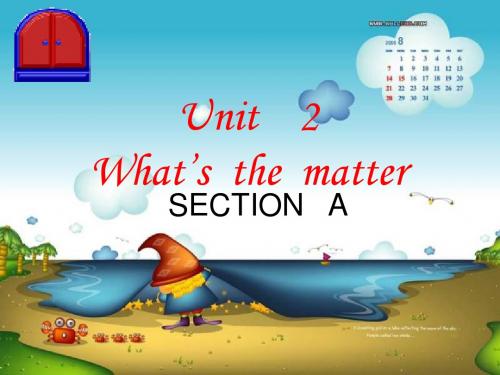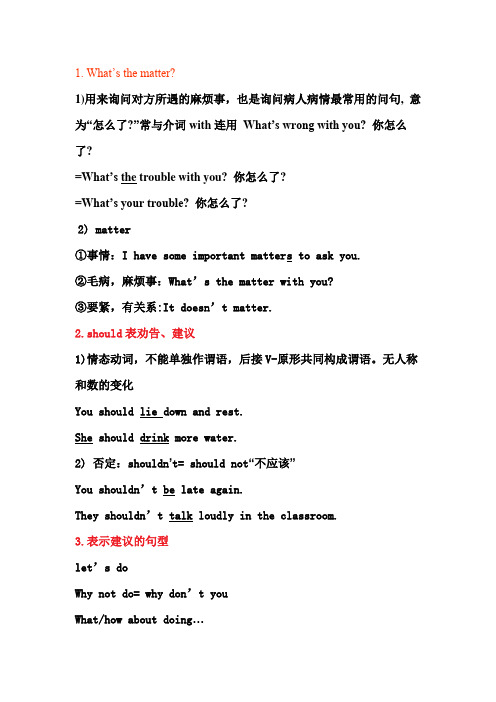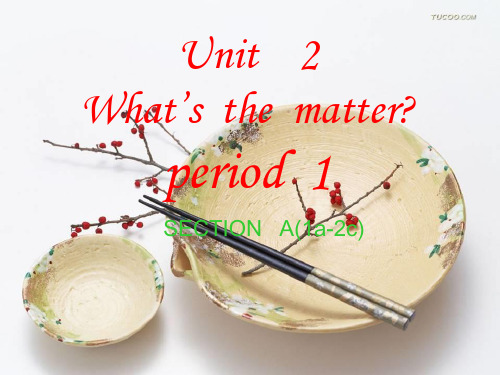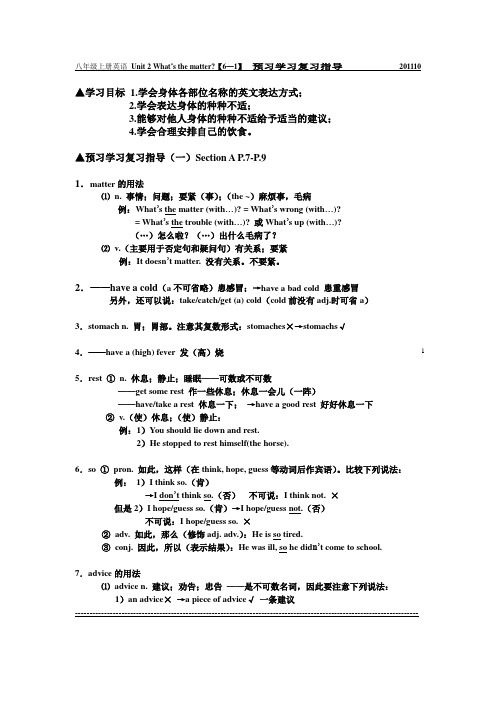Unit2 What's the matter
- 格式:doc
- 大小:33.50 KB
- 文档页数:3

Unit 2 What’s the matter?一、重点单词v动词:have得(病);患病stress 加压力于,使紧张believe相信,认为get变得stay保持,维持rest休息hear听见,听说n名词:matter 事情,问题cold受凉,感冒stomachache 胃痛back背,背部arm胳膊ear耳朵eye眼睛foot足,脚(复数:feet)hand手head头leg腿mouth嘴,口,口腔neck脖子nose鼻子stomach 胃,肚子,腹部tooth牙齿(复数:teeth)throat 喉咙toothache 牙痛fever发烧honey 蜂蜜dentist 牙医headache头痛illness疾病,身体不适advice 劝告,忠告problem问题,困惑的事情way方法,手段balance 平衡herb 药草,草本植物Dangshen 党参Huangqi 黄芪tofu 豆腐medicine药,药物diet 饮食;节食moment瞬间host family 寄宿家庭adj形容词:sore 疼痛的thirsty口渴的traditional传统的weak虚弱的angry愤怒的western西方的few很少的,几乎没有important重大的,重要的balanced 平衡的adv副词:ago以前early提早地pron代词:everybody每人;人人;各人so 如此;这样conj连词:until直到……之时;在……之前=tillmodal情态动词:should 应该shouldn’t=should not 联想:would 将,将要;愿意注:要熟练掌握人体器官名词二、重点短语1.lie down and rest 躺下休息2. sore throat 喉咙疼3.drink lots of water 喝大量的水lots of=a lot of 修饰可数与不可数名词注:water为不可数名词4.see a dentist 看牙医(注:用see)5.have a sore throat 区别:sore 因发炎引起的肌肉、喉咙疼痛,放在身体部位名词前面;—ache 持续性的疼痛,常与表示身体部分的名词结合构成复合词如:headache、toothachehave a cold 感冒have a headache/stomachache/toothache 头痛/胃痛/牙痛have a+名词表示患病的意思6.hot tea with honey 加蜂蜜的热茶7.eat something 吃一些东西否定句中用anything 例:You shouldn’t eat anything.8.feel well 感到舒服9. a good idea 一个好主意10.about a week ago 大约一个星期前11. I think so 我想是这样12.be stressed out 紧张的13. go to bed early 早点上床睡觉14.drink some water 喝一些水15. listen to music 听音乐16.traditional Chinese doctors 传统的中医17. for example 例如18.a balance of yin and yang 阴阳平衡19. eat hot yang foods 吃一些壮阳的食物20.Chinese medicine 中药21. be popular 受欢迎22.be weak/tired 虚弱/疲劳23. in many western countries 在许多的西方国家24.be easy to 很容易做某事25. have a healthy lifestyle 有一个健康的生活方式26.get tired 变得疲劳27. a few nights 几个晚上 a few+名词复数形式28.other healthy food 其他健康食品29. ask sb for advice 向某人征询建议30.give the best advice 给出最好的建议31. be important to…对……很重要32.sleep eight hours a night 一夜睡八个小时33. need to do sth 需要做某事34.get stressed out 变得紧张35. eat a balanced diet 均衡饮食36.stay/keep healthy 保持健康37. give you medicine 给你开药38.at the moment 现在39. have a lot of headaches 头很痛40.study late 学习很晚41. host family 寄宿家庭42.need some conversation practice 需要一些会话练习practice 不可数名词43.really nice 非常好44. too much 太多三、重点句型1.——What’s the matter with Gina?吉娜怎么了?——She’s tired. 她累了①tired 疲倦的它可以与be、feel、get、look搭配使用be tired 身体所处的状态feel tired 强调身体的感觉get tired 侧重身体的变化look tired 侧重视觉效果②What’s the matter? 询问别人的病情同义句:What’s wrong with you? What’s your trouble?③It doesn’t matter 一般用于回答对方的道歉,意思为没关系!2.I have a sore throat 我喉咙疼have 患(病)的意思have a+名词表示患有某种病症3.That’s a good idea. 那是个好主意4.Traditional Chinese doctors believe we need a balance of yin and yang to be healthy.传统中医认为阴阳平衡,这样才能健康。


1. What’s the matter?1)用来询问对方所遇的麻烦事,也是询问病人病情最常用的问句, 意为“怎么了?”常与介词with连用What’s wrong with you? 你怎么了?=What’s the trouble with you? 你怎么了?=What’s your trouble? 你怎么了?2) matter①事情:I have some important matters to ask you.②毛病,麻烦事:What’s the matter with you?③要紧,有关系:It doesn’t matter.2.should表劝告、建议1)情态动词,不能单独作谓语,后接V-原形共同构成谓语。
无人称和数的变化You should lie down and rest.She should drink more water.2) 否定:shouldn’t= should not“不应该”You shouldn’t be late again.They shouldn’t talk loudly in the classroom.3.表示建议的句型let’s doWhy not do= why don’t youWhat/how about doing…Would you like to do …?Shall we do…You’d better do …4.I’m not feeling well=I don’t feel well.=I feel terrible.1) feel“感觉到;觉得”。
系动词,后接adj.I feel cold.补充:系动词+adj.构成系表结构2) well此处为adj.意为“身体好的”,此时well不能用good代替。
回忆:well作adv. “好地”,修饰v.play well, sing well…5.I hope you feel better soon.(1) 这是一个宾语从句。


Unit2What’sthematter?教案教学设计(新课标版英语八年级)Unit 2 What’s the matter?Section A一、教师寄语Reading is to the mind what exercise is to the body. 读书养心,锻炼健身。
二、学习目标知识目标:Words: matter; have; cold; stomachache; sore; back; arm; ear; eye; foot; hand; head; leg; mouth; neck; nose; stomach; tooth; throat; toothache; fever; rest; honey; dentist; should; headache; shouldn’tPhrases: have a cold have a sore throat have a fever see a dentistSentences:1. What’s the matter? I have a cold.2. I have a headache/stomachache/toothache/sore back/sore throat.3. You should go to bed/drink some water.能力目标: Enable the students to talk about health problems and give advice with the language points.情感目标: Help the students learn how to talk about health problems and give advice on that with the language points.三、教学重、难点Talk about your health.and give advice.四、学习过程1预习导学或自测Ⅰ.Students look at the pictures on the blackboard and learnthe new words about the parts of the body.1. b______2. n_____3. he_____4. ha_____5. ea_____6. ey_____7. f______ 8. m_____ 9. ne_____10. a______ 11. s_______ 12. l_____2.自主学习1.看医生/牙医2.感冒3.患牙痛4.患头痛5.发烧6.躺下休息7.喝大量水 8.喝热蜂蜜茶9.有压力 10.保持健康3.合作探究 .完成表格后对话。

1 八年级上册英语 Unit2 What ’s the matter?【6—1】 预习学习复习指导 201110▲学习目标 1.学会身体各部位名称的英文表达方式;2.学会表达身体的种种不适;3.能够对他人身体的种种不适给予适当的建议;4.学会合理安排自己的饮食。
▲预习学习复习指导(一)Section A P.7-P.91.matter 的用法⑴ n. 事情;问题;要紧(事);(the ~)麻烦事,毛病例:What ’s the matter (with …)? = What ’s wrong (with …)?= What ’s the trouble (with …)? 或What ’s up (with …)?(…)怎么啦?(…)出什么毛病了?⑵ v.(主要用于否定句和疑问句)有关系;要紧例:It doesn ’t matter. 没有关系。
不要紧。
2.——have a cold (a 不可省略)患感冒;→have a bad cold 患重感冒另外,还可以说:take/catch/get (a) cold (cold 前没有adj.时可省a )3.stomach n. 胃;胃部。
注意其复数形式:stomaches ×→stomachs √4.——have a (high) fever 发(高)烧5.rest ① n. 休息;静止;睡眠——可数或不可数——get some rest 作一些休息;休息一会儿(一阵)——have/take a rest 休息一下; →have a good rest 好好休息一下② v.(使)休息;(使)静止:例:1)You should lie down and rest.2)He stopped to rest himself(the horse).6.so ① pron. 如此,这样(在think, hope, guess 等动词后作宾语)。
比较下列说法:例: 1)I think so.(肯)→I don ’t think so.(否) 不可说:I think not. ×但是2)I hope/guess so.(肯)→I hope/guess not.(否)不可说:I hope/guess so. ×② adv. 如此,那么(修饰adj. adv.):He is so tired.③ conj. 因此,所以(表示结果):He was ill, so he did n’t come to school.7.advice 的用法⑴ advice n. 建议;劝告;忠告 ——是不可数名词,因此要注意下列说法:1)an advice × →a piece of advice √ 一条建议 ----------------------------------------------------------------------------------------------------------------------2)two advices×→two pieces of advice√两条建议3)some advices×→some advice或some pieces of advice√一些建议⑵词组——ask for sb.’s advice =ask advice of sb. 征求某人的建议(劝告)——give sb. advice (on …) 给某人提出(关于……的)建议例:Mr. Smith gave us some advice on how to learn English.——take/follow one’s advice 接受某人的建议(劝告)——do sth. by/on one’s advice 根据某人的建议(劝告)做某事8.——tea with honey 蜜茶9.表示身体某部位疼痛的说法:①have a headache(earache, toothache, backache ,stomachache)头痛(牙痛,耳朵痛,背痛,胃痛)②have a sore throat 喉咙痛have a sore back = have a backache③其它部位的疼痛,常用动词ache 。
新目标八年级英语上册Unit 2 What's the matter?讲解与练习姓名班级讲解【重要词组】◆have a cold患感冒◆stressed out 紧张的,有压力的◆get tired感觉疲惫◆stay healthy保持健康◆at the moment此刻,现在◆see a doctor /dentist看医生/牙医◆go to the party去参加聚会◆have a sore throat嗓子痛◆get tired累了◆have a fever发烧,发热◆have a toothache牙痛◆have a sore back背痛◆lie down and rest躺下休息◆drink lots of water喝大量水◆drink hot tea with honey 喝热蜂蜜茶◆have a headache头痛【重要词句详解】1. How to talk about our health(怎样谈论健康)①问某人哪儿不舒服:What’s wro ng (with you) ?=What’s the matter (with you) ?=What’s your trouble ?=Is there anything wrong with you ? 都表示“你怎么了?”。
还有可能有如下的问法:What’s your trouble, young man? 年轻人, 你哪里不舒服? When did it start?从何时开始生病的?How are you (feeling) now?你现在觉得怎么样? Are you feeling better today?你今天好些了吗?Have you got a headache? 你头痛吗? When did you feel unwell?你什么时候觉得不舒服的?When did the pain start?疼痛何时开始的? Did you sleep well?你睡得好吗?Do you feel tired?你觉得疲劳吗? How long have you been like this?你像这样有多久了?Did you eat anything for breakfast?你早饭吃什么了?②叙述病情:There is something wrong with my tooth . 我的牙出问题了。
初二英语上册Unit 2 What’s the matter? 人教版(新目标)一、学习目标:1、知识目标:掌握本讲的词汇、短语和句型。
2、能力目标:学会询问他人的身体状况;能够对他人身体的某种不适给予适当的建议。
3、情感目标:学会关心他人,珍惜健康。
二、重点、难点:重点:掌握单词advice, enjoy, a few/few,短语too much/much too以及句型What’s the matter? I’m sorry to hear that. I don’t think…等的用法。
难点:a few/few/a little/little的辨析;对句型What’s the matter? I don’t think…准确理解和运用。
三、知能提升:(一)重点单词[单词学习]◎with【用法】with 介词,意为“有;带有”;with还可以表示使用工具、手段等,意为“用……”。
【例句】1. She is a beautiful girl with long hair.2. He cut the meat with a knife.【考查点】with的用法【易错点】把with理解成动词【考题链接】Mary bought a house a small garden. She will move in next week.A. fromB. withC. forD. has答案:B解题思路:with在此处表示“具有;带有”,句意为“玛丽买了一所带有一个小花园的房子。
下周她将搬进去。
”所以选B。
◎advice【用法】advice为不可数名词,意为“劝告;忠告;建议”,可用some, a piece of, pieces of等修饰。
表示“有关……的建议”,可后接介词on,再接名词、代词或由疑问词引导的不定式。
【例句】Mr. Green will give us some advice on how to learn English.【考查点】不可数名词的量的表达【易错点】错把advice用作可数名词【考题链接】He gave me some (advice).答案:advice解题思路:advice是一个不可数名词,没有复数形式。
Unit 2 What's the matter?一、一周课程概述1.学习谈论健康情况。
2.学习有关提出建议的表达。
3.学习情态动词should, shouldn't的用法。
4.学习几种表示疾病的表达形式:have a cold, have a sore throat, have a headache, have a toothache等。
二、重难点句子解析1.—What’s the matter? 怎么了?—I have a cold. 我患感冒了。
(1)matter作名词时,表“事情;问题;情况”,What’s the matter? 常用来询问对方的病情或其他不适,也可用What’s wrong? 或What's the trouble with sb.? 来表示,如要说明对象,则需要用介词with表示。
如:▲What’s the matter, little boy?小男孩,你有什么事?▲What’s wrong / the matter with her? 她怎么了?※wrong是形容词,前面没有“the”; matter和trouble都是名词,前面应有“the”,trouble前还可以用形容词性的物主代词。
▲What's your trouble, young man?年轻人,你怎么了?2.I have a sore throat. 我喉咙痛。
(1)have vt.患(得)病,(不用于进行时态)▲He had a bad cold last week.他上周患了重感冒。
▲She often has a stomachache. 她常胃(肚子)疼。
※一般情况下用have+a+n.(病名)表示“患了某种疾病”。
have a cold 感冒have a sore back 背痛have a stomachache 胃痛have a sore throat 嗓子痛have a toothache 牙痛have a headache 头痛have a fever发烧have a backache 背痛注意a在此不表示数量“一”,而是不定冠词加名词表示一类事物。
Unit 2 What’s the matter?高庄初中李荣辉Teaching content: Section A, Period OneTeaching aims and demands :nguage target:a)To Learn English names of the body parts of expression way .b) To master the new words: cold, matter, stomach, sore, throat,headache, stomachache, sore back, backache, sore throat, toothache, feverc) To learn how to express the uncomfortable body.d) To master the sentence patterns: What’s the matter with you? I have a …. You should...e) To learn how to give advice about the illness.2.Skill aims:a)Students can talk about the parts of their bodies..b)Students can talk about what’s the matter with sb.c)Students can give advice to others.d)Students can listen and get information about what’s the matter .3.Emotional objects:Students can know the importance of the health.Do exercise every day and keep healthy and strong.Teaching key points:1.To review the parts of the body.2.To learn the new parts of the body and some illnesses.3.To give advice to the patients.Teaching difficulties:Students may feel hard to give adviceTeaching methods: task-based teaching, discussion, classifying Teaching steps:Step1. Warming-up (song).Greet and get the students ready for the class.Task 1 Parts of the body.Step 2 Listen to a song and do some activitiesThe teacher do the activities and the students following.Step3. Review and learn the wordshead , face, arm, foot(feet), tooth(teeth), stomach, mouth, back, ear, eye, leg, back, throat, nose, handAsk students to repeat the words .Step4. Game time Touch and say Boys PK GirlsTouch the parts of your body when you hear I say…The last one to stay here is the winner.(Ask three boys and three girls to go to the front of the classroom.)Task 2 what’s the matter?Step5.Show some pictures about some illnesses.Learn some new words: headache, stomachache, sore back, backache,sore throat, toothache, feverThe teacher asks: What’s the matter with him/her?Students answer: He/She has a …Step6.Listening 1b Listen and look at the picture.Then number the names (1-5).Conversation1: Nurse: What’s the matter, Sarah?Girl: I have a cold.Conversation2: Nurse: What’s the matter, David?Boy: I have a stomachache.Conversation3: Nurse: What’s the matter, Ben?Boy: I have a sore back.Conversation4: Nurse: What’s the matter, Nancy?Girl: I have a toothache.Conversation5: Nurse: What’s the matter, Judy?Girl: I have a sore throat.Then ask students to listen again, fill in the blanks.Step 7 Pair workMake a conversation like this:What’s the matter with ….?He/ She has a ….Task3 Give adviceThe teacher says , “ I have a cold these days. Can you give me some advice?Ask students to give me some adviceThey may use , “ You should ….”Step8 Show the pictures of illness on the big screen. Ask students to talk about what’s the matter with them and what they should do.Step 9 Guessing game (boys PK girls): What’s the matter with them? What’s should they do?Let students guess with the help of photos.Step10 Group workWho is the highly skilled doctor?Five students make a group and one student acts as a doctor. The others act as patients.The doctor writes down the medical record, and at last , read the medical record.Step11. SummarizeShow the sentences on the screen.Eat right! Sleep right! Exercise to keep right!(Show the importance of the health and encourage students to do more exercise.)Homework1. Remember the new words.2. Interview your family members and write 2 dialogues on their health.课例分析中学阶段的英语教学目标是培养和提高学生的综合语言运用能力。
教师指导、帮助学生用英语获取信息、处理信息,学生积极主动地参与到课堂教学中,充分发挥自己的学习潜能,掌握英语语言知识和语言技能。
通过师生互动、生生互动来实现语言的交际,使学生在交际中通过体验、感悟、总结、归纳而获取知识,从而提高语言的综合运用能力。
网络教学环境通过以多媒体和网络通讯技术为代表的现代信息技术有效的整合建构起一种理想的学习环境,这种环境“可以支持真实的情境创设、不受时空限制的资源共享、快速灵活的信息获取、丰富多样的交互方式、打破地域界限的协作交流,以及有利于培养学生创造性的自主发现和自主探索”,可以实现一种能充分体现学生主体作用的全新学习方式。
网络技术为师生之间的交流与互动提供了多种通讯机制与交流手段。
在网络环境中,教育信息的显示呈多媒体化,教学过程具有较强的交互性,教育信息的传递呈网络化、智能化,这使网络环境下的教与学更具魅力,教学模式也与传统教学有了巨大的不同,教师和学生的地位也发生了根本的变化。
在网络环境中,用电子邮件、语言信箱或其他网上媒体交流手段与他人进行交流活动,学生和老师之间,学生和学生之间可以在线进行提问、回答、讨论、辩论、协商,从而可以有效地实现与他人协作与交流。
充分利用网络拓展课堂容量,增加与教学内容有关的动画、影像、图片等素材,利用优美的外国名曲、生动的卡通动画、场景环境等声音、图像、文字多种媒体向学生展示图、文、声、像结合的丰富多彩的教学内容,为学生创设愉快的语言学习氛围,让学生从上课开始就进入一个具有魅力、引人入胜的学习境界,加深了学生对课文的理解和记忆,变学生“要我学”为“我要学”,引发学生的创新思维。